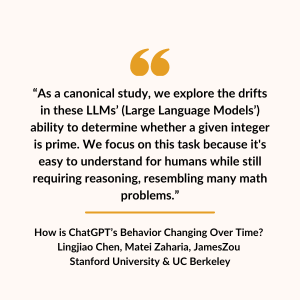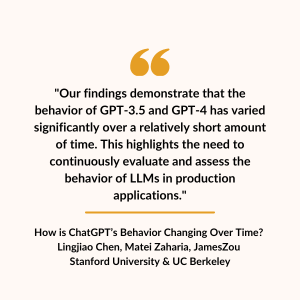A decline in AI’s math accuracy raises questions about the quality and reliability of using this tool during the content creation process.
The Rise of ChatGPT and its Initial Accuracy
ChatGPT, an AI language model developed by OpenAI, initially revolutionized the field of math problem-solving. At first, it had an impressive accuracy rate of 98%. People would use this tool to solve complex equations quickly and accurately, conduct numerical analyses, and receive step-by-step explanations.
But it isn’t just math. Here are some examples of how people use AI to assist in various industries:
- Finance: Investment banks use this tool to generate detailed financial reports, analyze market trends, and predict stock fluctuations.
- Academia: If it isn’t against the student code of conduct, students can use AI to solve complex math problems, write scholarly essays, and engage in scientific discussions.
- Marketing: Marketers use this tool to ideate and inform the content creation process.
- Customer support: Companies use this tool to answer customer questions and resolve issues more quickly and efficiently.
- Data analysis: Businesses use AI to analyze large datasets and identify patterns and trends.
 Despite these use cases, a study shows that the math accuracy rate of 98% has plummeted to 2%.
Despite these use cases, a study shows that the math accuracy rate of 98% has plummeted to 2%.
But why?
The Mysterious Plummet: Research Findings
In the study I mentioned, researchers found that OpenAI’s GPT-4 technology can fluctuate wildly in its ability to perform certain tasks. The study looked at two versions of the model, one from March and one from June.
The study states, “As a canonical study, we explore the drifts in these LLMs’ (Large Language Models’) ability to determine whether a given integer is prime. We focus on this task because it’s easy to understand for humans while still requiring reasoning, resembling many math problems.”
In March, GPT-4 correctly identified that the number 17077 is a prime number 97.6% of the time. However, just three months later, its accuracy on this task plummeted to 2.4%.
Meanwhile, the GPT-3.5 model showed conflicting results. In March, GPT-3.5 could correctly identify 17077 as a prime number just 7.4% of the time. However, by June, its accuracy on this task had increased to 86.8%.
The researchers attributed this wild fluctuation in performance to how GPT-4 is trained. It’s trained on an immense dataset of text and code, including math problems. When GPT-4 is first trained, it can learn to solve math problems relatively well.
However, as it’s exposed to more data, it also learns other – sometimes inaccurate – things. Unfortunately, this exposure could lead to the tool forgetting how to solve math problems or – worse – learning to solve them incorrectly.
 The researchers conclude, “Our findings demonstrate that the behavior of GPT-3.5 and GPT-4 has varied significantly over a relatively short amount of time. This highlights the need to continuously evaluate and assess the behavior of LLMs in production applications.”
The researchers conclude, “Our findings demonstrate that the behavior of GPT-3.5 and GPT-4 has varied significantly over a relatively short amount of time. This highlights the need to continuously evaluate and assess the behavior of LLMs in production applications.”
In other words, GPT-4 isn’t reliable for solving math problems – yet. The researchers also mentioned they’re continuing to study this to see if the problem continues.
The Impact on Content Creation
Okay, so what do math inaccuracies have to do with content creation?
Well, nothing – and – everything.
Think of it this way: If you’re using AI for content creation, how do you know the generated text is reliable? The information above about the decline in math accuracy tells a good story and also spurs the question, “If it isn’t reliable for math, is it reliable for generating text?”
The short answer: Maybe.
Before unpacking that, let’s look at a couple of challenges faced by content creators who use AI:
- Accuracy and reliability: As pointed out, AI-generated content is not always accurate or reliable. Despite the datasets they’re trained on, these tools can still make mistakes.
- Creativity and originality: Because you’re essentially using a robot to generate text, it’s not always creative or original. Sometimes the content is too robotic, repetitive, or formulaic.
The button line – a human must always be involved with content creation. Human touch is required not only for writing and fact-checking but also for editing. The only way to ensure accuracy is to use multiple sources during creation and verification. Using more than one source is something we all learned when writing term papers in school, and you can’t do that with AI.
Let’s dig into “human touch” a bit deeper.
Mitigating the Accuracy Decline With a Human Touch Approach in Content Creation
 There’s no doubt that AI isn’t going anywhere anytime soon. Because of the decline in accuracy, content creators and editors must take steps to mitigate it with a human-touch approach. Here are some mitigation tips:
There’s no doubt that AI isn’t going anywhere anytime soon. Because of the decline in accuracy, content creators and editors must take steps to mitigate it with a human-touch approach. Here are some mitigation tips:
Conducting Research and Gathering Data
Conducting research and gathering data is important for accuracy during the content creation process because it helps you:
- Understand your audience: Learn about your audience’s interests, needs, and pain points. This information will help you to create content that is relevant and engaging.
- Stay up-to-date on industry trends: This strategy ensures your content is accurate and up-to-date. Doing so helps you build trust with your audience and position yourself as an expert in your field.
- Prove the value of your content: By gathering data on the impact of your content, you can prove its value to your audience and stakeholders. This will help you to get buy-in for your content creation efforts and justify the time and resources that you invest in them.
Here are some specific data collection methods that you can use to improve the accuracy of your content:
- Surveys: These are a great way to gather data from a large group of people. Send surveys asking your audience about their interests, needs, and pain points.
- Interviews: Interviewing provides a more in-depth way to gather data. Use interviews to get a better understanding of your audience’s motivations and thought processes.
- Content analysis: This involves analyzing text to identify patterns and themes. Use content analysis to gather data on the types of content that interest your audience and how they consume content.
- Social media monitoring: This strategy can help you track the conversations around your brand and industry. Using this information can help identify trends and topics important to your audience.
Implementing Quality Control Practices
Create clear policies and train your staff to adhere to them. Quality control includes:
- Creating a content brief: This document outlines the content’s goals, target audience, and key messages. This information can guide the content creation process and ensure that it’s aligned with the company’s goals.
- Engaging with qualified freelance writers: The content’s quality is directly affected by the quality of the writers creating it. It’s important to vet writers with the skills and experience to create high-quality content.
- Using a style guide: This document outlines your company’s writing style and formatting guidelines. This can help to ensure that the content is consistent and error-free.
- Having multiple people review the content: Following the content creation process, it’s important to have multiple people review it before publication. This can help catch any errors and ensure accuracy and relevancy.
- Using a content management system (CMS): This system can help automate some tasks involved in quality control, like checking spelling and grammar.
- Tracking the content’s performance: It’s important to track the performance of the content to see how well it resonates with the target audience. This information can be used to improve the quality of future content.
Ensuring Accuracy and Quality With nDash’s Human Content Creation
Having concerns about the quality and accuracy of AI-generated content is natural after reading studies about its decline. Our pool of freelance writers is skilled in creating content that’s accurate and of the highest quality. Contact us today to learn more about how to leverage our talent pool and elevate the content creation process.
